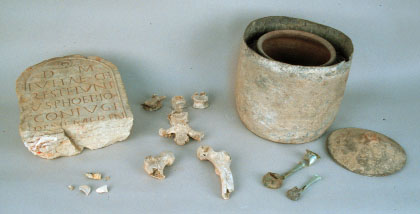



What can we learn from this assemblage created from artifacts in the Kelsey Museum?** The grave marker reads: To the gods of the netherworld, To Julia Crestes Junius Phoebion for his wife--well deserving it--he made it." Clues to the life of this woman were given by inspection of the remaining bones inside the urn and the associated grave goods. Mixed with the ashes are three femurs (two left and one right), all female. This indicates that there are at least two individuals' cremated remains in this assemblage. By examining parts of the skull, the ages of the women can be estimated. One was approximately forty years old and the other was in her mid-twenties.
Why two women? The tombstone only indicates one burial. There are many possible explanations. The other bones may have been added at a later date to increase the value of the urn and its contents on the modern day black market. This commonly occurs in cases where locals discover ancient burials and try to make a profit from their findings. The fact that several animal bones were also found in the cremated remains also suggests this is a viable explanation, since it is unlikely that animals would have been mixed with the original cremation. Another possible explanation for the extra bones is that the cremated remains of another family member or slave may later have been placed in the same urn with the original burial. It is unlikely we will ever know the final story here.
Based upon the scant traces of gold found with the remains, it is likely that the person originally buried here was most likely a middle class citizen. Due to gold's high melting point (approximately 1000 degrees C.), any large pieces ofjewelry she might have been wearing at the time of her funeral would be more intact. The amount of gold in these remains is surely too small for any sort of extravagant display. Possibly the gold preserved here was part of the fabric of her clothing.
Some remains of glass unguentaria and carved bone were also present in the urn. Unguentaria, or "tear bottles", were commonly placed with the body before cremation. These vessels frequently contained ritual oils and perfumes. The original nature and purpose of the carved bone fragments, however, are still up for speculation. These may have come from a cosmetics box, candle holder, or musical instrument, and indicate the presence, together with tiny fragments of some bronze object (perhaps a coin), of other grave goods in the cremation.
**Please note: this "assemblage" was created solely for educational purposes. While the cremation urn KM 2903 and its contents may reflect an actual burial (it was purchased in the 1920's in Puteoli, Italy), the other objects in this "assemblage" (inscription, columbarium, and melted glass) do not come from the same archaeological context. A full explanation of this class project is found on the introductory page for this website.